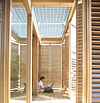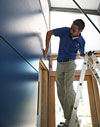
Oak louvers on the Technishe Universitat Darmstadt’s solar
powered home provide shading and privacy for visitors to the Solar Decathlon on
the National Mall in Washington last October. (Photo by Kaye
Evans-Lutterodt/Solar Decathlon.)
The need to go green is part of a long-term strategy that has global implications, according to speakers at the American Society of Heating, Refrigerating, and Air-Conditioning Engineers (ASHRAE) IAQ conference in Baltimore in October.
Keynote speaker Hal Levin, Hal Levin & Associates, pointed out that the need to reduce energy consumption isn’t necessarily due to fewer energy resources, but due to “reduced atmosphere,” and the need to reduce the load of contaminants there.
He called reducing the load on the atmosphere a matter of species survival for human beings.
Air conditioning, as a primary user of electricity generated by mainly coal-fired power plants, is a large contributor to the greenhouse gas load. With a spreading global emphasis on improving the Earth’s atmosphere, we should expect to see more technologies that help reduce the load by means of lower electric consumption.
Technologies such as geothermal and solar heating-cooling, though well known, could well play a stronger role in the near future.
Solar technologies are getting a boost from local programs such as the Solar-to-Market Initiative in Massachusetts, which featured a $5.3 million loan fund to support manufacturers, research and development, supply companies, and other solar photovoltaic (PV) businesses in the state. In addition to reducing energy consumption, the industry helps to create jobs.
The solar market got a lot of exposure in Washington last month, when entrants from around the world built solar-powered homes for the U.S. Department of Energy’s Solar Decathlon. The Solar Decathlon complements President George Bush’s Solar America Initiative, which is said to seek to make solar energy cost-competitive with conventional forms of electricity by 2015.

A Penn State student works hard to finalize details before
architectural jurors tour the home in the Solar Decathlon. (Photo by Kaye
Evans-Lutterodt/Solar Decathlon.)
IN THE MEANTIME
Technologies such as heat pumps and dual-fuel unitary products will help provide interim solutions. “We definitely see a trend of increasing dual-fuel systems, which use both natural gas and electricity for heating, and can operate with either fuel, depending on what is most economical for the consumer,” said Matt Lattanzi, director of product and brand management for Nordyne.“Increasing energy costs are driving it, and the desire for more-efficient systems to save the consumer on energy costs.” This trend, along with utility rebates, is driving that technology, he said.
“Dual-fuel systems not only tend to be more efficient - 14 SEER and 8 HSPF for the Maytag iHybrid™ system - but also, it’s a rising trend in technology to give the consumer that ability to switch from one service to another,” Lattanzi said. “For example, the thermostat manufacturers have dual-fuel system controls embedded in the thermostat. That saves on some upfront costs,” he said. “It’s also an easier installation.”

Northern climate heat pumps and dual-fuel unitary products
could help provide interim solutions to reduce energy consumption.
“The first Boomers are starting to retire. Some of the installers coming into the industry, English isn’t necessarily their first language. Anything we can do to make the installation easier is better.”
Regarding service, “I think there’s a trend for manufacturers to make the equipment more and more installation friendly through electronics and circuit boards.” He added, “We see manufacturers developing equipment on a communication bus, where it recognizes, ‘Hey, I’ve got a 3-ton unit.’” Communications and diagnostics are on an upward trend as well, Lattanzi said.
“One of our vendors has been developing communicating circuit boards that give diagnostics for their compressors. Those are trend indicators and we see that.”
Publication date:11/12/2007

Report Abusive Comment